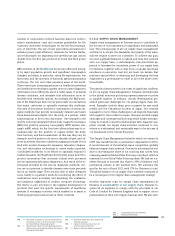Siemens 2011 Annual Report Download - page 169
Download and view the complete annual report
Please find page 169 of the 2011 Siemens annual report below. You can navigate through the pages in the report by either clicking on the pages listed below, or by using the keyword search tool below to find specific information within the annual report.
153 D. Consolidated Financial Statements
273 E. Additional information
143 C.2 Additional information for supplemental
financial measures
145 C. Siemens AG (Discussion on basis of
German Commercial Code)
151 C. Notes and forward-looking statements
140 C. Information required pursuant to Section ()
and Section () no. of the German Commer-
cial Code (HGB) and explanatory report
142 C. Compensation report and Corporate Governance
statement pursuant to Section a of the German
Commercial Code (HGB)
Governance – processes and definitions – The qualification
of Environmental Portfolio elements as well as their respec-
tive reporting is based on defined processes and criteria.
In principle, products, systems, solutions and services of
Siemens AG and its subsidiaries may qualify for the Environ-
mental Portfolio. The entire Siemens business portfolio is re-
viewed annually regarding the qualification of Environmental
Portfolio elements based on the criteria described below. This
covers the inclusion of newly developed elements as well as
the integration of additionally qualified elements where evi-
dence of fulfillment of the qualification criteria was not avail-
able in prior reporting periods. For additionally qualified Envi-
ronmental Portfolio elements, we report their prior-year reve-
nue and prior-year contribution to reducing customer carbon
dioxide emissions on a comparable basis. Elements that no
longer fulfill our qualification criteria are excluded from our
Environmental Portfolio.
Prior to inclusion in the Environmental Portfolio, potential
new Environmental Portfolio elements have to undergo a mul-
tilevel internal evaluation process. The Siemens Sustainability
Board annually acknowledges changes in the composition of
the Environmental Portfolio. One task of the Sustainability
Board is also to discuss potential concerns of stakeholders
with regard to the inclusion or deletion of certain technolo-
gies in the Environmental Portfolio.
Criteria for inclusion of Environmental Portfolio elements –
An Environmental Portfolio element can be a product, a sys-
tem, a solution or a service as defined above. Furthermore, a
core component of a system or solution may qualify as an En-
vironmental Portfolio element if the component provided by
Siemens is key to enabling environmental benefits resulting
from the system’s or solution’s overall application. To qualify
for inclusion in the Environmental Portfolio, an element must
meet one of the selection criteria, which are energy efficiency,
renewable energy or environmental technologies. Products,
systems, solutions and services with planned application in
military use or nuclear power are not included in the Environ-
mental Portfolio.
> Energy efficiency: The criteria for energy efficiency are an
improvement in energy efficiency of % or more during
the customer use phase compared to the applicable base-
line, or a reduction of at least , metric tons of carbon
dioxide equivalents per reporting period in the customer
use phase. Examples of elements that meet the energy effi-
ciency criterion are combined cycle power plants and intel-
ligent building technology systems.
> Renewable energy: This criterion covers technologies in
the field of renewable energy sources such as wind turbines
and solar power or smart grid applications and their respec-
tive core components.
> Environmental technologies: This criterion is related to
water and wastewater treatment, air pollution control,
waste reduction, recycling, e-car infrastructure and its core
components. Additionally, a criterion for the Healthcare Sec-
tor is an environmental impact reduction in terms of noise,
radiation or total weight of at least % compared to the
baseline.
Baseline methods – Energy efficiency, annual customer re-
duction of carbon dioxide and environmental impact are all
assessed by a comparison with a reference solution (base-
line). There are three different options for the reference solu-
tion: before-after comparison, comparison with a reference
technology or comparison with the installed base. The base-
lines are reviewed annually and, if necessary, adjusted, such
as when statistical data on the installed base is updated be-
cause of technical innovations or regulatory changes. The cal-
culation of the reduction of carbon dioxide emissions is based
on a comparison for every relevant Environmental Portfolio el-
ement with a baseline. For this calculation, we focus on those
elements that have a material impact on the overall carbon di-
oxide emissions reduction. For some emission reduction cal-
culations, the baseline reference for the installed base is de-
termined using known global emission factors such as those
for power production. The baselines used for our calculations
are mainly based on data of the International Energy Agency
(IEA) for gross power production and for grid losses, on data
from the Intergovernmental Panel on Climate Change (IPCC)
for fuel based emission factors, and our own assessments of
power production efficiency. For consistency reasons, we gen-
erally apply global emission factors for calculating emission
reductions.
Reporting estimates – The inclusion of elements in the Envi-
ronmental Portfolio is based on criteria, methodologies and
assumptions that other companies and other stakeholders
may view differently. Factors that may cause differences,
among others, are: choice of applicable baseline methodolo-
gy, application of global emission factors that may be differ-
ent from local conditions, use patterns at customers that may
be different from standard use patterns used for carbon diox-
ide abatement calculations and expert estimates if no other
data is available.
























